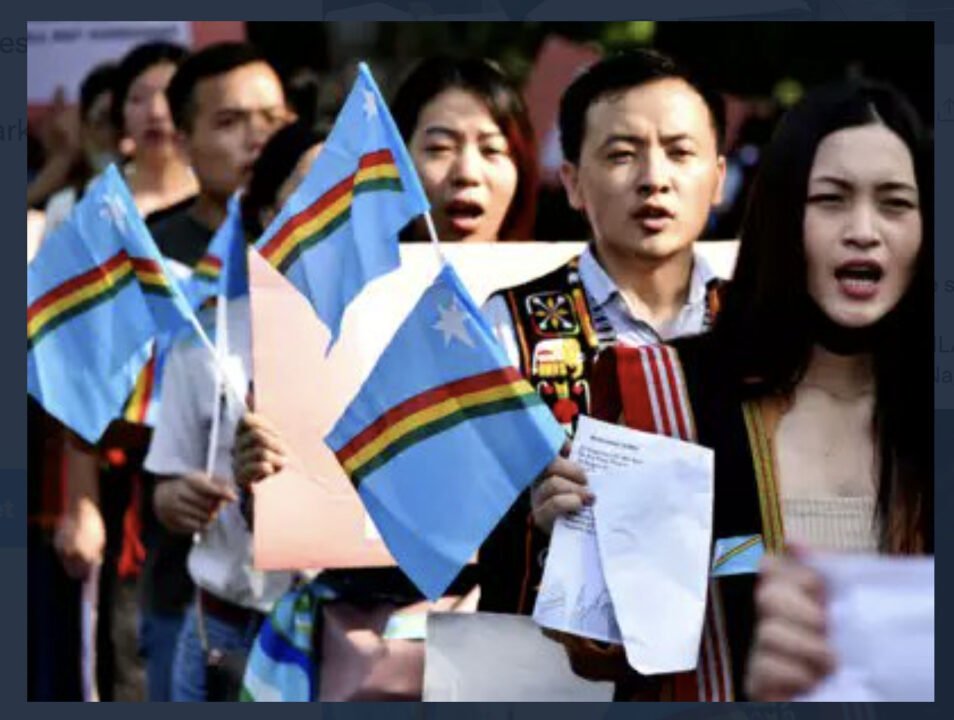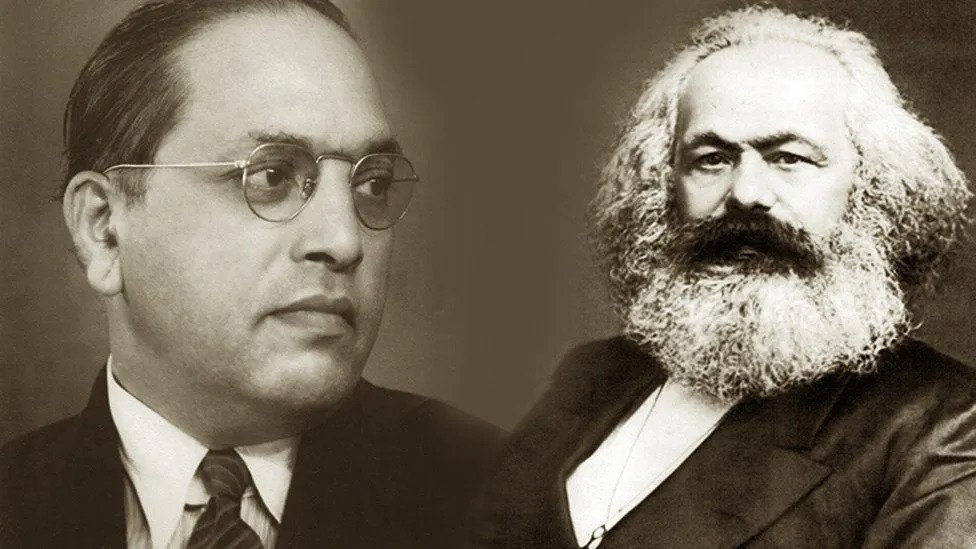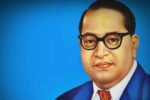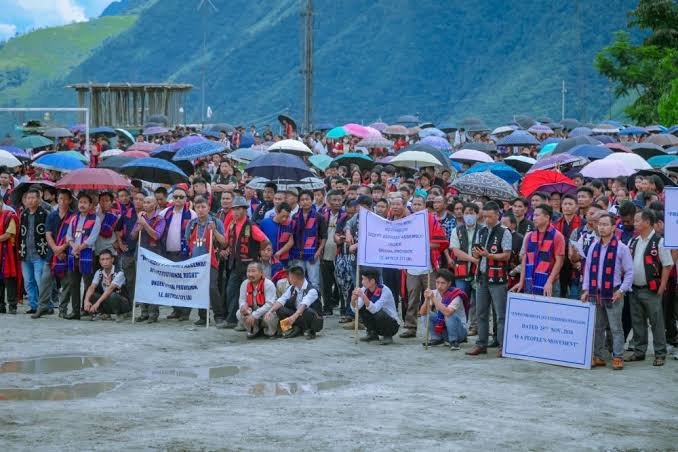By: Dr. Aniruddha Babar
“Man is mortal. Everyone has to die some day or the other. But one must resolve to lay down one’s life in enriching the noble ideals of self-respect and in bettering one’s human life. We are not slaves. Nothing is more disgraceful for a brave man than to live life devoid of self-respect.” ~ Dr. B.R. Ambedkar
The demand of Frontier Nagaland is primarily based on the notion of considering ‘State’ as a resource through which backward people will achieve their development needs, in social, political, and economic areas, and by which they will receive new opportunities of growth, which they lacked since more than 80 years. Eastern people classify themselves as backward, while use of such terms for classifying the communities is long extinct. However, the feeling of backwardness coming from deep within a community is a major challenge to contemporary social, political, and economic advancement that the state of Nagaland is making in one region while the other is deprived of them. The concerns of the people from Eastern Nagaland has become a grave challenge to the ‘Democracy’ of India and her vision to become an ‘Economic super-power’.
Evidences have shown that exposure to western education paved the path for the development of the Pan-Naga consciousness, and this also became a reason due to which some of the highly educated Naga people (those from the western Nagaland) became the representative of the entire Naga population. Educated sections of the Naga population understood the importance of gaining their distinct identity and formed the Naga Club in 1918 for representing Naga people. However, the educated people not only got the opportunity of representing their entire population, but they also got better opportunity of securing their position in administrative and government jobs. These people significantly favoured their own clans and communities and paid little or no attention towards the eastern Naga people, who were far behind.
Some of the major fault lines have been identified in the governance structure, attitude of government towards different tribes, and the facilities and opportunities provided to different tribes. Naga tribes were given the status of the scheduled tribes (STs) under the Constitution of India. Under the Pan-Naga consciousness that was mainly generated by the educated and civilized western Naga representatives, all STs in the Naga region were assumed to be marginalized. This is because this was considered as the blanket categorization, which was opposed by eastern Nagas. What were mainly concealed within the blanket categorization were the differential trajectories and problems, social inequalities and inconsistencies, and power hierarchies, which were specifically prevailing within the STs in Nagaland. Therefore, the lack of governance and the understanding of the main problem deprived the eastern Naga people of getting the status they deserved. This also resulted in giving rise to the developmental discrepancies between the dominant western tribes and other backward tribes. The problem is not about addressing the dominance of one tribe over another, rather the problem is recognizing the difference between the developed and underdeveloped tribes.
This is also a reason that eastern Naga tribes demand a new state under the name Frontier Nagaland in order to fill this difference. They consider ‘State’ as the instrument of change, which will provide them with sovereignty in their geographical area and will also allow them to have their political entity, which they lack under the power and dominance of western tribes. The three significant elements associated with statehood are population, territory, and government. The element of population in statehood theory is associated with the development, growth, freedom, and equality that every citizen of the state should receive. A state provides the population with their identity that helps them to grow and get equal opportunities in education and employment and get equal access to resources. A demand for a state is to implement their own power and to not remain subjected to external power. A demand for state ushers the demand of equal material welfare for every individual.
Second important element is territory, which means to have the right over their geographical boundaries and properties. Eastern Naga tribes identify that their lands and resources are being exploited by the western tribes and that they are left with limited opportunities of development through their resources on which they have lived for centuries. The third important element that is associated with the demand of a new and independent state is government. Government here refers to the government bodies, institutions, officials, and policies. It has been identified that the dominant groups representing the government in Nagaland are the people from western tribes. Most of the government officials posted in the eastern region are either western Nagas or the non-Nagas, who consider their posting in the region to be a ‘punishment’. These officials consider the place to be very backward and primitive and are often found to be absent from their offices. Eastern Naga people demand a new state because they found that the western Naga officers posted in their region often neglect their duties.
ENPO in their formal launch of the statehood demand had stated that among all the districts of Nagaland, eastern districts are most backward. They also stated that they were not administered by British rule and no missionaries reached them, and as a result, no schools were established nor any kind of development took place in their area. However, instead of helping the eastern tribes to grow and develop, they had been exploited by the dominant western tribes ever since the State of Nagaland was formed. Also, the developmental budgets for the Eastern Nagaland have been kept by the western tribes who used all resources. ENPO believes that with the formation of their Independent state, they would become the sole beneficiaries of all the state resources. Therefore, they are considering State as the resource and as the instrument of change through which districts of the eastern Nagaland region can achieve their development, which has become necessary in the globalized world.
Various evidences also inform that the social attitude and mindset of the western tribes towards the eastern tribes has been a significant barrier in their growth. Most of the officials if not all working in the eastern region have an attitude that this region will remain backward, as there is a lack of development, education and employment and that these people could never modernize. As people in the eastern region are hardly educated, government representatives take them for granted and do not focus on their demands and needs. Therefore, with the ‘backwardness’, there is also a perspective of discrimination against them that eastern people experience through the powerful western Nagas.
It is also believed that the demand for a separate State jeopardising the “Naga Political Issue” however, the ENPO did not see it in this way and consider that their purpose is not to influence any political dialogue. They require their demand to be considered on a different level and must be seen through the problem of development-deficit eastern region. The lack of development in the eastern region was not accidental, but this has been because of the cumulative failure of Government in terms of their projects and priorities. We have to understand and accept the fact that the statehood demand primarily revolves around the ‘claims that [in] almost all the decision making or policy matters, [advanced Western Naga tribes] played the determining role’. Besides the various records and narratives of the evident neglect towards the region, there was also a historical backdrop that displayed a boundary between Nagaland and Frontier Nagaland, which in broader sense could be compared with the colonial divisions between administered and unadministered regions.
There have been counter contentions in public discourses as to making the Eastern region political representatives responsible for the ‘pathetic’ condition of Eastern Nagaland. There is a great amount of truth in it. When Eastern Nagaland was brutally assaulted in all the times and ages by Kohima through its apathy, negligence and corrupt policies, the Members of Legislative Assembly and the Ministers representing the region kept ‘mum’, not a single word came out of their mouth. However, why should their silence be surprising to the people who understand nook and corner of the politics and political dynamics in Nagaland? When the Ministers have been handpicked and henpecked by their political master and supreme commander (from every political party and government that ruled Nagaland), When there is constant fear of losing portfolio hanging over the head twenty four hours, what do you expect from Ministers? Eastern Ministers and MLAs have not yet fully grasped their duties towards the people and most importantly their rights under the Constitution of India, otherwise they would have roared like a Lion watching their land and the people getting dishonoured. As I take stand as a people’s Advocate and free man of free nation, I do not see any reason as to why the ‘people of Eastern Nagaland’ should exonerate ‘those’ MLAs and Ministers who represented the Eastern region from time to time in the Government of Nagaland from their crime of “Silence” and “Illegal Omissions” (either willingly or under duress), however what at present, the people of Eastern Nagaland expect from 20 MLAs including Ministers is nothing but the awakening of a pinch of “Self-Respect” in their hearts in the best interest of the present and the future of all those oppressed people rotting in the ‘suffocating’ darkness of the jungles of the ‘East’ or ‘slaving’ in the backyards and kitchens of rich and advance people in Dimapur, Chumukedima, Kohima, Mokokchung, Peren etc.
The question of Eastern Nagaland is more a question of self-respect and restoration of Constitutional Rights of lost and forgotten people. Since I am closely associated with the people and the land of the east, I can read their ‘age old silence’ better than anybody else. What moral right does Kohima have to boast its notion of development and justice in Nagaland when it can’t even construct a road to ‘so called’ International Trade Centre, Dan at Noklak? Why people living in Thanamir, Khongjiri, Choklangkan, Wui, Chipur, Sanglao, Wansoi and so many other villages should trust Kohima when they know very well that they will never ever get a humane road condition, standard medical facilities, infrastructural development and compassionate government support which they truly deserve to uplift themselves? Where is the correct, valid and legal implementation of “Gram Sadak Yojana” in Eastern Nagaland? What about availability of quality Doctors, medical staff and super speciality hospitals in appropriate number in the region? Why should Eastern villages be forced to go to sleep in the absence of quality electricity and road lamps? Why should there be only one Government College in each eastern district? (Noklak, Shamator does not have any government college). How did government fail to stop Drug dealings and cross border human trafficking? There could be many more uncomfortable questions to which Kohima will not have any concrete answer.
People of the Eastern Nagaland have been doubly discriminated- firstly, in the hands of the successive governments of Nagaland and secondly in the hands of their own MLAs and Ministers. Will it be possible for Government of Nagaland to rectify its omissions and give the Eastern people their dues and lawful share? I think it is already too late for that. As I have clearly maintained from time to time, that the Naga Polity have now become very rigid and complicated. ‘Political Demography’ dominated by the Western Tribes and Tribal dynamics is something that has become a permanent “Structural reality” of modern day Nagaland which transformed the entire ‘Naga Polity’ into a kind of a tall building without staircase where both the entities i.e. the Easterners and Westerners will remain where they are. In such a condition, Eastern people cannot even dream of reaching to a decision making position in political spectrum of the state of Nagaland. Will there ever be a Chief Minister from Eastern region, I doubt, this is next to impossible knowing well that all the successive Chief Ministers of Nagaland have been from ‘advance tribe’ constituencies like Northern Angami-II, Peren, Aognlenden, Atoizu, Mokokchung Town, Kohima Town, Akuluto, Western Angami, Impur and this trend is likely to continue.
The state of Nagaland benefitted from the ‘FUNDS’ that it has received from New Delhi. Development has been ‘rushing into Nagaland’ riding over the shoulders of the ‘money’ from Central Government. The Finance Commission Grant from the Centre to Nagaland are budgeted to be Rs 4773 crore in 2022-23, a significant increase over Rs 1283 crore that was released in 2009-10. In addition, a total of Rs 455 crore and Rs 1600 crore has been allotted to Nagaland under Special Assistance to States for capital expenditure, the FM highlighted. What difference did this sanctioned amount or any other FUND that came from the center made in the life of people living in the Eastern Nagaland?
Our Naga society is not easy to understand and Naga polity is a big mystery to decipher for the outsiders, foreigners and mainlanders. The governance of Nagaland has become an ‘untouchable’ topic for discussion. People actually avoid it. Who will like to be shamed before others? Outside writers, scholars, researchers visit Nagaland, spend time in libraries and taverns, delight themselves in the culture, talk to people, occasionally fall in love with our beautiful women, click photographs, live in ‘imagination’ that they know and understand Nagaland, make their notes and go back to their world where they write book or thesis in their protected, air-conditioned, well-lit study room or a library, sometimes they even win awards for their writing- but our Naga people remained where they are.
Mainland Indians and foreigners failed to understand the ‘truth’ of our people. Whoever came to Nagaland got drowned in the colours of our culture and blinded by the radiant beauty of our people- but could never reached to the final frontiers of ‘Truth’. No expectations from others, but I have great expectations from the awakened, free men and women of todays’ “New Nagaland” who have liberated themselves from the prisons of petty tribal interests, narrow mindedness and selfish needs – at least they can understand the pain, suffering and needs of the invisible people of the Eastern Nagaland.
ENPO, ENSF and all the people of Eastern Nagaland are all geared up to reclaim their constitutional rights and most importantly their ‘Human Personality’ through their strong determination to build the land of their dream – “The Frontier Nagaland”. Government of India has been observing the region for so long. Central Government knows very well what the deprived and discriminated people of the Eastern region have been going through and how the region have been treated by the successive governments of Nagaland.
Government at the center ALSO exists to protect us from each other. The will of the people is the source and the happiness of the people the end of all legitimate government upon earth, which I believe, Central Government understands. As mandated by the supreme law of the land- The Constitution, Government of India is duty bound to listen to the grievances of Eastern people and initiate remedial measures as demanded by them – that is- the Formation of separate state – The Frontier Nagaland.
As Dr. B.R. Ambedkar said, “Equality may be a fiction but nonetheless one must accept it as a governing principle” – this governing principle that Babasaheb advocated whole his life was completely missing throughout the political history of the state of Nagaland.
As I am informed, struggle for the Frontier Nagaland will continue. The state of Nagaland is going through an epic era- an era of awakening of people. The rising people of the Eastern Nagaland are fully determined to achieve the statehood through constitutional means.
My student once asked me. “What according to you is the measure of the progress of the Nagaland”? I answered, “I measure the progress of our Nagaland by the degree of a progress which people from Tikhir and Khiamniungan Tribes have achieved. Their contentment, their happiness, their progress, their success, their contribution and share in the success story and glory of India and the Nagaland will be the ultimate yardstick to measure the success of Nagaland”.
There was an uncomfortable silence-which we both-me and my student endured. (The author is a lecturer at the Dept. of Political Science, Tetso College, Nagaland)







